
Atlas F1 GP Editor
Toyota took advantage of the sleepy summer break to overhaul the team's management and drivers' line up, sacking members of the team - even those who've been around since the Japanese outfit entered Formula One four years ago. Seemingly, all these changes - as well as the signing of Ralf Schumacher for next season - were pushed through by the new technical director Mike Gascoyne. Is Toyota being Gascoynised? Atlas F1's David Cameron finds out what the main players think of the recent changes
"We are looking to make real progress [towards] the top teams this year," Tomita, who took over as team principal at the start of the year, continued. "I believe [we] will achieve point-scoring race results during each F1 weekend in 2004. I also believe we can score our first ever podium finish."
It hasn't quite worked out that way; the team has a total of eight points for the year to date, and they are in seventh place in the Constructors' Championship, only one point ahead of the struggling Jaguar team.
There are a number of reasons for Toyota's disappointing form. This year's Championship has been unquestionably tough, but excuses get short shrift in Formula One, and the team has recently made a number of changes aimed solely at moving their performance forward.
The most outwardly obvious of these was the replacement of Cristiano da Matta as race driver by the team's third driver Ricardo Zonta. "Well, it was a very difficult decision, a difficult thing to do," Technical Director Mike Gascoyne noted on the move in the Budapest paddock. "Ultimately you can say Ricardo qualified 15th and Cristiano qualified 15th at his last race so what's the difference, but I think you've got to give Ricardo a little bit of a chance - I think he has performed really well.
"There's been a mixed reaction (to the driver change) I think it's quite interesting when you get the feedback - 50% have said 'I'm surprised it took you that long', and the other 50% have said 'poor old Cristiano'. I think all of us say poor old Cristiano sure, he didn't deserve it but ultimately are we right? Well it's a tough call."
The reaction has been curious; there doesn't seem to have been any outraged commentaries about the move, and da Matta had failed to set the paddock alight with his abilities during his time there. On the other hand, there hasn't been a large groundswell of support for Zonta either mostly the move has been seen as giving Zonta one last bite of the cherry to prove his worth to a generally unforgiving series.
"There are no rights and wrongs," Gascoyne continued. "Ricardo has performed very well, and we wanted to take a look at what he can do in a race situation. It's a very difficult call for the positive sides the downsides of it, sure, Cristiano can't be blamed for our lack of results this year because he's driving a car that blatantly isn't quick enough, and we've been very open about that. Having said that, as a driver you are at the sharp end and you stand by your performances, and there have been disappointments on his side as well.
In a way, the removal of Cristiano da Matta is the most minor of the recent moves made by the senior Toyota management. They've replaced one Brazilian driver with another in a car that even Gascoyne admitted was not up to the job, and the new driver is certainly going to be keen to prove his worth. More strikingly, the management structure of the organisation has been given a shake up, with a number of engineers being moved around and two senior members of the team being left standing when the music stopped.
Since its inception, Toyota's F1 team has had a reputation for being top heavy managerially. Last year, in an interview with Atlas F1, Richard Cregan noted that "if you compare us to probably any of the other Formula One teams the words 'top heavy' do come to mind. But [Toyota Motorsport president] John Howett came on board at the beginning of this year, and obviously John has to have time to come in and review everything to see where he's going with the team. He's already started to do a lot of constructive changes within the company to make us more efficient."
A year on and the changes are taking shape. "When we started in Formula One," Cregan says today, "we obviously had a structure in place that at the time we thought to be the best for the job at hand, and we quickly realised we had too many people at the track, and we had to make sure we had the right people at the track. This process was in motion over that time, and then Mike came on board at the end of last year with the experience he has, and this obviously added a lot of experience to the team.
"With Mike on board we sat down and said okay, what do we need to do to make this an efficient operation, an efficient team that can handle a good car, good drivers and can go out there and win races? And we sat down and started to work on that, and this is part of that process. And it will make it a leaner operation, it will make it a more efficient operation, and above all I believe that when we get our car for 2005 and the updates for this year, then we as a team will be able to handle them and get the best out of them. That's what it's all about."
John Howett had an explanation for these moves: "Norbert Kreyer really decided that he'd like to leave us, at his request; he found it quite difficult to work with Mike, and he himself made the decision that ultimately he wanted to leave. So taking that opportunity we decided that we really needed to lean down the organisation, because we had some overlap I think in the area of Norbert, Richard Cregan and Ange, so we then decided that we would actually restructure the race organisation as a consequence of that change. In the end we're running the format that we wanted to run next year, and we've got six races to actually look at the organisation and format to see and test whether it works."
In a company the size of Toyota, overlap is a big concern. "When you look at it in terms of the team manager role," Gascoyne explained, "Richard Cregan and Gianfranco Fantutsi beneath him basically fulfill the role of team manager and logistics - now that's a role I'm used to being done by two people, and we also had Ange Pasquali here, so there were three people doing it - we basically rationalised that and made it more efficient.
"The race and test department included the race team; it also included a lot of R&D functions vehicle dynamics and the test bench, seven point rigs and all of that. My feeling was that this was an incorrect way to be set up; I think those roles should be far more design orientated and led roles, rather than race and test testing the car we've got, I want those tools used in a predictive way to make the next one better, not to work out why this one doesn't go very well.
"Formula One should very much have a design led philosophy, and we were reacting, not predicting. So really the race and test department has changed from quite a big department to a much smaller department that is just going racing, and really that's why the position of Norbert became less important. In the end, with mutual discussions, he didn't want to continue in that role with those changes, which was understandable, and it was very much a mutual decision. Whereas with Ange there was a necessity to slim down the operations."
It is clear that Gascoyne has been very busy since starting with the team, and there is a lot of speculation in the paddock as to what the 'Gascoynification' of Toyota will mean for the team. The team existed before him, and although the Technical Director has a clearly large say in the operation, the moves are not all down to him. "I think that if you want to knock holes in a wall, you put the lintels in first before you take the doorways out," Howett noted, "so for me it's not a Gascoynification Toyota decided we wanted a technical director; we selected Mike. I think you can expect ongoing changes as we focus on our objective those will be made as they need to be. Mike is an important part of the team, but we've also got [Technical Director Engine] Luca Marmorini on the engine side, and to me it's a clear Toyotaisation really it's us taking the team to where we want it to be."
The departure of Kreyer is different he remains with the team until the end of December for a start, and the position he held was becoming much reduced in the short term. Kreyer, a former engine builder who was given his position when the team brought in Marmorini from Ferrari to effectively replace him, was relatively unhappy about his diminishing stance in the company, and, as Howett acknowledged, a fractious relationship with Gascoyne (which Gascoyne edged away from: "I think we disagreed professionally, but hopefully not personally") couldn't have helped.
The role of testing in Formula One is changing, as Cregan, who now takes a larger role overseeing testing, noted: "I think the way the regulations are going, and the way the agreements and the discussions (have been) among the teams, certainly the target is to reduce the amount of testing that has been done. What I do believe is that it will emphasise how you do your in-house testing, so your test bench area becomes very, very important, and your assimilation departments and things like that, and that was all part of how we've done our reorganisation."
With the increase in the number of races over the last few years, a process that looks to continue next year with 19 weekends held aside for the Formula One calendar, the emphasis in testing is moving away from just putting in the miles to what Howett describes as "reducing testing as a volume and going for quality rather than quantity." It's a process that all of the major teams are undergoing, and Toyota simply cannot be left behind.
But any change in personnel will have an effect on those who remain, and given the family nature of the team and their staff it is a concern for future productivity. "I think whenever you change anything it causes a degree of uncertainty," agreed Howett. "I've been with Toyota for a long time, but Toyota is a company that changes the culture of Toyota is always to scrap and build or find a new dimension. So I think it's culturally totally in line with Toyota, and I sincerely hope we don't destroy the family spirit that we have, and the close working relations.
"Whenever you change, you know people are to some extent uncertain about it, but on the other hand one has to change to deliver the performance that you want to achieve I think we have to be open to change in the future as well." Gascoyne took it a step further, noting: "I think internally there's a lot of frustration that results aren't better, and a lot of people can see that things need to be changed - I would say in the factory that all of the changes have been received fairly positively."
Making these moves has given Toyota another advantage with the new drivers next year will be a vital one in their history, and they can effectively take the remainder of this year as a practice to make sure things work as smoothly as possible in the future. "I think it gives all of us the opportunity to experience the different drivers, the different positions, the position changes that have taken place, and I think that's very positive," Cregan noted.
"We have the six races until the end of the year to see how everyone performs, to look at it closely, and then when we prepare for next year, take that into consideration, and then put our team together for 2005. But I think what has happened on the operation and team management side, the people who have been changed around are the same people who have been on the track, and we look at it like we have a team of good people and we just have to be sure that they're in the right positions. I think so far it's worked quite well, considering all of the changes for this weekend."
"We said seven months ago we'd have an updated car for Hockenheim, and that meant we had to do all the work, and then design the parts, make them and get them there - it was a big update and we hit it and got it there. In the past they've done things in the wind tunnel, made them and then the car's no quicker, but we did a lot of changes, worked in a particular way, updated the whole of the car, made it, and had exactly the sort of gain we expected.
"That really vindicated the process, which was exactly the process that I've used to make cars successful in the past. So now it's there, it's in place, and it's going to work. It's now just a matter of time it's not if, but when. The great thing is if you can have some good results it motivates people, makes it so much easier to do. And when you have results everyone in Japan relaxes. At the moment it's quite (hectic), but then again that's what they pay me to put up with I've got to be strong and say no, I know it's going to be right, we've got to keep doing this', and you've got to keep everyone motivated and going until the results come along.
"It was the same at Benetton in the middle of 2001 I was going to get sacked, Flavio was going to get sacked, everyone was leaving, it was all rubbish but that time the year afterwards everything was great, everyone wanted to join us, and everything was sunny. That'll be the case here we're just going through the difficult bit but as I say I'm very comfortable and very happy that we're on the charge now."
At the launch of Toyota's new Formula One car, on January 17th this year, newly appointed team boss Tsutomu Tomita was clear on their objectives for the season: "Everyone in the team is fully committed to rapid, continuous improvement and teamwork, and it is my firm belief that this will allow Panasonic Toyota Racing to make its biggest step forward in 2004."
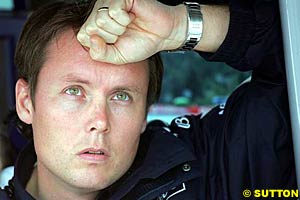 There was good reason to feel confident the team was rolling on from top three qualifying positions in the last two races of the previous season, the car was lighter, stiffer and more aerodynamically efficient than its predecessor, the resources and finances were in place to help propel the team up the grid, and they had recently brought Mike Gascoyne on board, the man behind the rebirth at Renault.
There was good reason to feel confident the team was rolling on from top three qualifying positions in the last two races of the previous season, the car was lighter, stiffer and more aerodynamically efficient than its predecessor, the resources and finances were in place to help propel the team up the grid, and they had recently brought Mike Gascoyne on board, the man behind the rebirth at Renault.
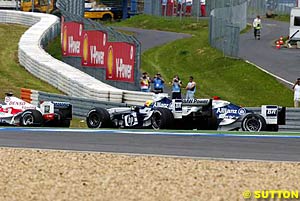 "But when you look at the positives of the change we get to see what Ricardo can do, to see whether he can be one of our drivers for next year, and we get to see Ryan (Briscoe, replacing Zonta as third driver) in a Grand Prix environment to decide whether we should invest in him further. We made some changes in terms of engineers and in the race team operation with a view to next year, because next year we're going to have Ralf [Schumacher] and we need to be working in a better way. So there are a lot of positives that could come out of the changes, but ultimately are we going to get better results? I don't think we'll get any worse results whether we get better results, come and see me at the end of the year and tell me whether I was right or I was wrong."
"But when you look at the positives of the change we get to see what Ricardo can do, to see whether he can be one of our drivers for next year, and we get to see Ryan (Briscoe, replacing Zonta as third driver) in a Grand Prix environment to decide whether we should invest in him further. We made some changes in terms of engineers and in the race team operation with a view to next year, because next year we're going to have Ralf [Schumacher] and we need to be working in a better way. So there are a lot of positives that could come out of the changes, but ultimately are we going to get better results? I don't think we'll get any worse results whether we get better results, come and see me at the end of the year and tell me whether I was right or I was wrong."
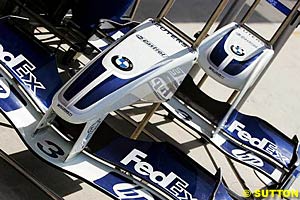 The two major changes made were the removal of Ange Pasquali from the role of Team Manager (Cregan has been since moved into this slot from his previous position as General Manager of the F1 Operation) and Norbert Kreyer from his role heading up the Race and Test department.
The two major changes made were the removal of Ange Pasquali from the role of Team Manager (Cregan has been since moved into this slot from his previous position as General Manager of the F1 Operation) and Norbert Kreyer from his role heading up the Race and Test department.
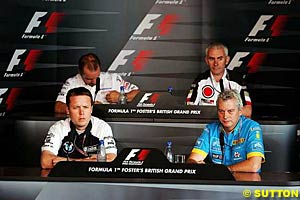 Formula One runs on the backs of an enormous number of people, but communication lines between them all are important if people don't know what they are supposed to be doing, things are done poorly. The departure of Pasquali is understandable from this point of view three into two doesn't go and despite his issuance of a press release where he acknowledged his "shock and surprise" at the move, from the outside it makes sense.
Formula One runs on the backs of an enormous number of people, but communication lines between them all are important if people don't know what they are supposed to be doing, things are done poorly. The departure of Pasquali is understandable from this point of view three into two doesn't go and despite his issuance of a press release where he acknowledged his "shock and surprise" at the move, from the outside it makes sense.
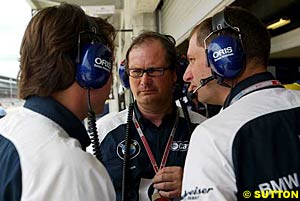 The last word, as ever, goes to Gascoyne - a veiled warning for those who have written off the Japanese giant's hope of future glory. "When you put a load of changes in place, you have to do six months of changing things and then actually you don't have much time to get the update through. When we design next year's car, what we've done in six weeks we've got six months to do, and it's a much bigger step forward. So I'm very confident, to be honest, because I've seen it before, I know it works, and I know it's happening.
The last word, as ever, goes to Gascoyne - a veiled warning for those who have written off the Japanese giant's hope of future glory. "When you put a load of changes in place, you have to do six months of changing things and then actually you don't have much time to get the update through. When we design next year's car, what we've done in six weeks we've got six months to do, and it's a much bigger step forward. So I'm very confident, to be honest, because I've seen it before, I know it works, and I know it's happening.
|
Contact the Author Contact the Editor |
Please Contact Us for permission to republish this or any other material from Atlas F1.
|
Volume 10, Issue 34
Articles
The Long Road
For The Record
Every Other Sunday
2004 Belgian GP Preview
2004 Belgian GP Preview
Belgian GP Facts & Stats
The F1 Trivia Quiz
Columns
On the Road
Elsewhere in Racing
The Weekly Grapevine
> Homepage |